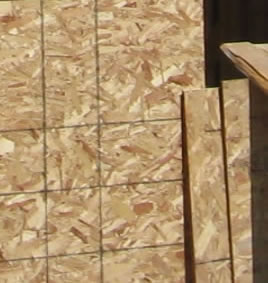Product description
Oriented strandboard (OSB) is a structural wood panel made from strands of wood cut from small logs. OSB panels are lightweight and easy to handle and install.

OSB is mainly used as a floor and wall sheathing in traditional platform-frame constructed buildings (single or multi-family housing). It can also be found in mid-rise residential and non-residential construction.
Other applications include the manufacturing of other engineered wood products like wood I-joists.
Technical information
OSB is made by bonding together strands of abundant, small diameter poplar and aspen trees with a waterproof phenolic adhesive. The boards are then cured under heat and pressure, producing an economical structural panel using under-utilized wood species and forest residues.
OSB is manufactured with the surface layer strands aligned in the long panel direction, while the inner layers have random or cross alignment. Similar to plywood, OSB is stronger along the long axis compared to the narrow axis. This random or cross orientation of the strands and wafers results in a structural engineered wood panel with consistent stiffness and strength properties, as well as dimensional stability. The strands used in the manufacturing of OSB are generally up to 150 mm (6 in) long in the grain direction, 25 mm (1 in) wide and less than 1 mm (1/32 in) in thickness.
OSB panels are manufactured in thicknesses ranging from ¼ inch to 2½ inches, typically produced in 4x8 foot panels. Panels may be square edged or tongue-and-grooved to aid in the connection of adjacent panels on site. OSB has particularly good nail-holding properties and can be glued with regular wood adhesives.